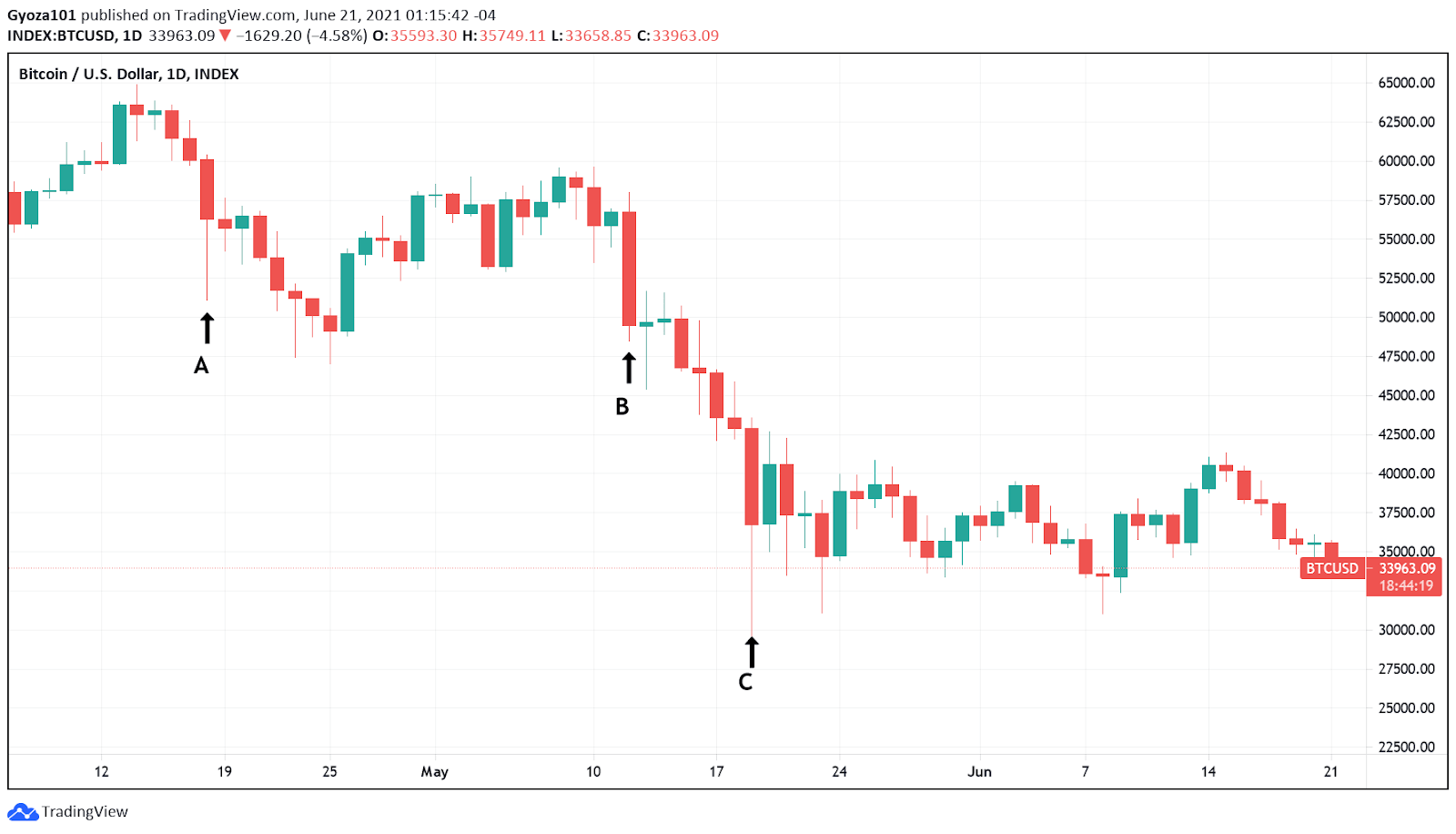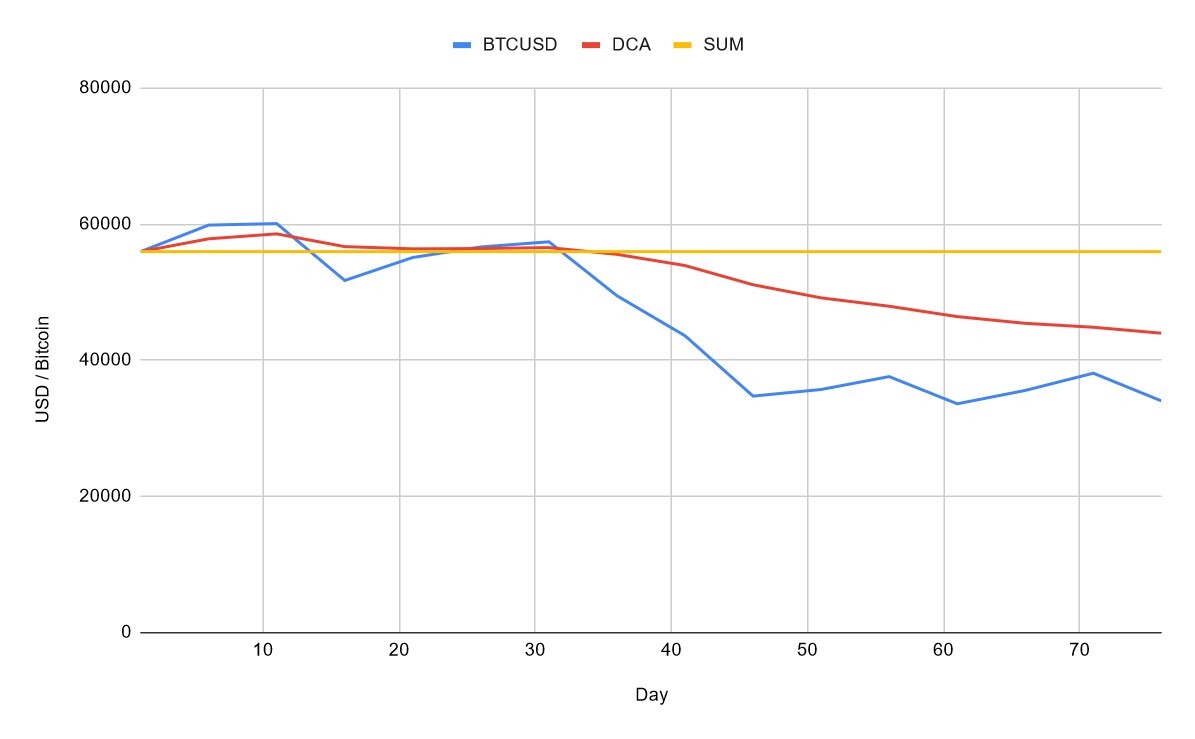Investing Crypto in the Bear Market
Now that the bull run has calmed down a bit – what are some ways to start investing crypto in the bear market?


In early 2021, the crypto market was well known as the market to make lots of money. The bull run that was sustained since April 2020 had multiplied many ordinary people’s investments, and the early birds were particularly the lucky ones to catch the ride early. Now that the bull run has calmed down a bit – what are some ways to start investing crypto in the bear market?
Dollar-cost averaging – an effective way for investing crypto in the bear market?
In such moments of market euphoria, it is difficult for some to adopt a more disciplined cryptocurrency investment strategy such as the dollar-cost averaging. In the bull run, it seemed that putting in a lump sum of money on crypto was the most logical and profitable thing to do.
Is dollar-cost averaging not effective when it comes to crypto? We argue that it is more important than ever to adopt this strategy, especially when the market is coming to a downturn. Dollar-cost averaging (DCA) may be the best way to manage risk in the bear market condition.
Learn more: Read our guide on dollar-cost averaging.
The crypto market condition in June 2021
Bitcoin’s price chart, with its incredible momentum that dwarfs its 2017 all-time high, has become somewhat of a symbol of hope for some, and a red flag warning for others who are still not yet convinced with cryptocurrency technologies.
Of course, like in all markets, what comes up must come down again — Bitcoin is no exception. If we go back in time just a few months back to show the “Bitcoin bulls” in the chart below, no one would believe it.

They would think that Bitcoin’s price movements should be characterised by small dips making “flag patterns” with a general upward trend with an unimaginable growth rate. Yet, believe it or not, this is the most recent price data (at the time of writing) since the all-time high in April 2021.
The sharp drops here have been caused by notable events such as:
- The drop in the Bitcoin hash rate due to a flood in China, and the uncertainty caused by an unconfirmed rumor of a cryptocurrency crackdown in the US.
- Elon Musk stated on Twitter that Tesla, Inc. will suspend payment in Bitcoin, citing environmental concerns.
- News that China will be more serious in implementing a crackdown on Bitcoin miners in the country.
The price of Bitcoin and other cryptocurrencies may fall relative to fiat currencies such as the US dollar. Coincidentally, the stock markets worldwide are also experiencing an uneasy time. The crypto bear market, one that could last a few months to a couple of years, might be coming.
This doesn’t mean that cryptocurrencies will lose all of their value eventually. We’ve already highlighted why that is nearly impossible.
Also, when you have picked a crypto asset as fundamentally strong as Bitcoin, Litecoin, Cardano, XRP, Polkadot, Solana, and Chainlink among others, a short crypto winter is just a temporary setback in the grand scheme of things.
Learn more about crypto prices: What gives cryptocurrency its value?
Why the dollar-cost averaging works in the bear market
Essentially, the goal of the dollar-cost averaging strategy is to invest in an asset using the same amount of money, regardless of market conditions. The price average of an invested asset is calculated by dividing the total amount of money invested by the total quantity of assets.
The average price of asset = Total invested amount of money ÷ Total quantity of the asset
If most of the assets had been bought at a lower price in the previous period compared to today’s market price, then on average, the average price is lower than today’s market price.
In the simplest terms, investing is all about keeping the average price lower than the market price, in order to create substantial profits in the future.
We feel it’s important to mention that during the bear market while employing the dollar-cost averaging strategy, you will still hold a floating loss. The loss, however, will not be greater than if you had invested in a lump sum.
Below is the closing price of Bitcoin over more than 70 days after the April 2021 all-time high.

In a hypothetical case, two investors were given $1600 of capital to invest. Jack uses the dollar-cost averaging method to buy $100 of Bitcoin every five days.
Clara uses the lump sum investing strategy, as she believes that even if Bitcoin were to dip slightly, it would still continue to move upwards.
By the last day, both investors take a look at their floating loss. Clara had bought $1600 worth of Bitcoin at the price of US $55,940. The current market price for Bitcoin is around $34,013. She’ll have to stomach a -64% return in her portfolio.
Meanwhile, keeping to the plan, Jack had depleted all of his $1600 capital and is now looking at a -29% return in his portfolio, which is relatively not too shabby.
Other benefits of the dollar-cost averaging in the bear market
In the hypothetical example, if Jack had continued his practice of buying a consistent amount of Bitcoin, and if Bitcoin prices continue to go sideways, the average price of the invested assets is still going to be lower, which is always a good thing to have for an asset that is projected to be valuable in the future.
Bitcoin is still too important and too volatile to stale and die off like a penny stock that had lost all of its value. If the average price of invested Bitcoin and the price of Bitcoin is only a few percentages apart, a sudden pump in price will already be a trigger for a profitable exit.
In contrast, Clara must wait perhaps a few months or a couple of years to see the Bitcoin price recovering again to the 2021 all-time high level.
The takeaway
Lump-sum investing isn’t always bad, particularly if you are astute enough to identify the recovery phase after the bear market ends. While it comes with multiple times the return as if you had used dollar-cost averaging, it also brings high risk.
However, for something as volatile as cryptocurrencies, the best crypto investors aren’t the best at analysing the market and price charts, but someone who could stick to their investment plan, and using time-tested strategies such as the dollar-cost averaging.
Hopefully, this discussion has proven insightful for those of you considering investing crypto in the bear market!
Further reading: Explore our library of crypto investment topics on our Learn Site.
Note: The discussions presented in this article are meant to serve as informational and educational content. It is not to be interpreted as financial advice. As with any investment endeavors, it’s best to conduct your own empirical research and understand the fundamental risks involved.
Share to
Stay curious and informed
Your info will be handled according to our Privacy Policy.
Make sure to follow our Twitter, Instagram, and YouTube channel to stay up-to-date with Easy Crypto!
Also, don’t forget to subscribe to our monthly newsletter to have the latest crypto insights, news, and updates delivered to our inbox.
Disclaimer: Information is current as at the date of publication. This is general information only and is not intended to be advice. Crypto is volatile, carries risk and the value can go up and down. Past performance is not an indicator of future returns. Please do your own research.
Last updated September 5, 2023





